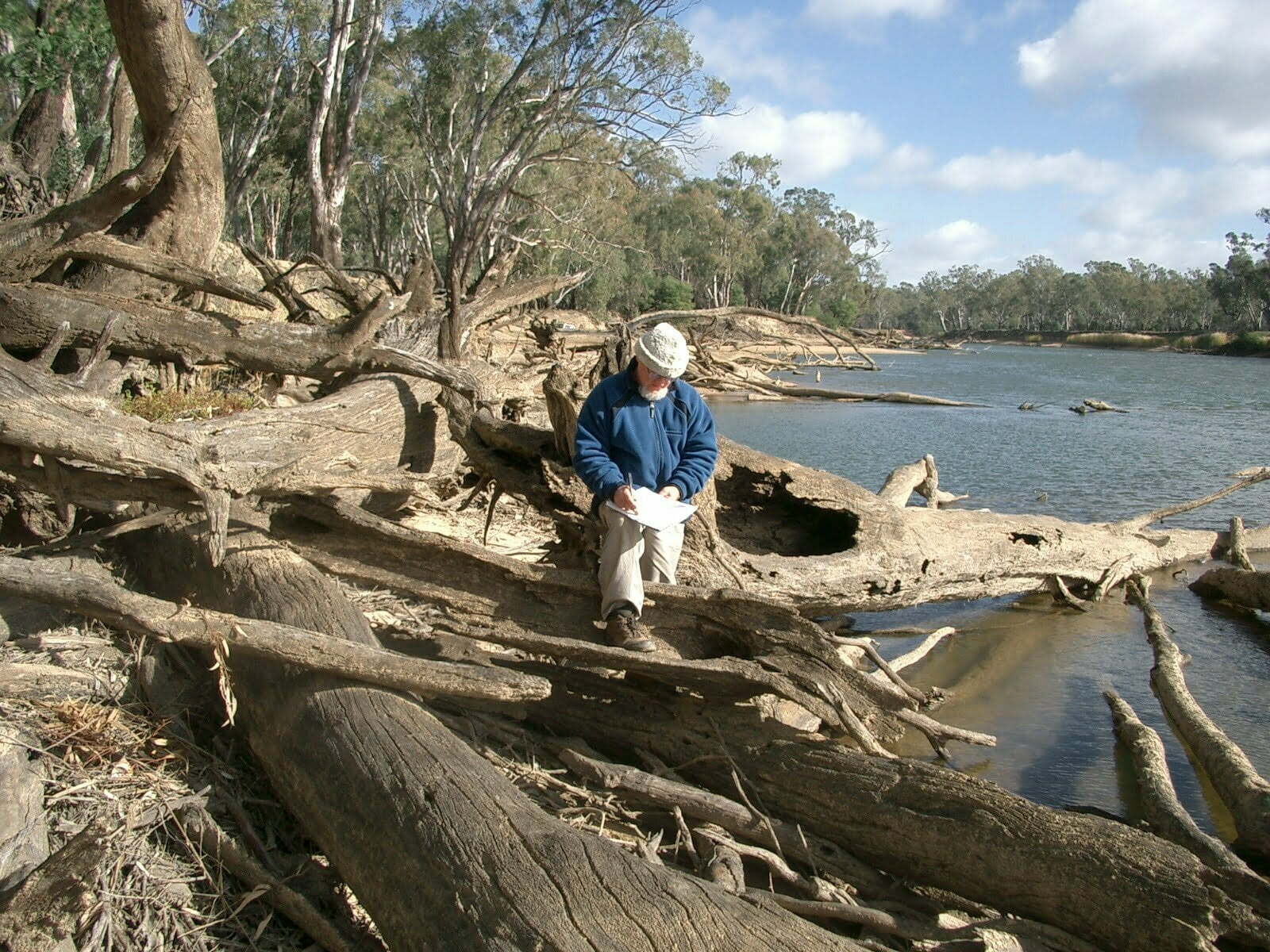
Quick Tips:
- Most instream habitat works focus on reintroducing wood to provide shelter, food and homes for fish, as well as creating hydraulic diversity. Local authorities must be contacted to ensure compliance with any regulatory requirements.
- Woody debris loads need to be based on the natural load for the particular river.
- Woody debris needs to be native to the riparian zone, but not sourced from there.
- Logging or land clearing sites are potentially good sources of woody debris, but the closer to the demonstration reach the better to avoid excessive costs.
- Expertise needs to be sought in placing the woody debris to avoid danger to existing infrastructure.
- Anchoring may be required to achieve stability. Trunks with root wads still intact will assist in this process.
- Heavy equipment (e.g. excavators) will be required to place woody debris in the river. Damage to the riparian zone should be avoided wherever possible.
Reintroducing Large Woody Debris:
Large woody debris consists of accumulations of woody materials (branches or whole tree trunks) that have fallen onto the stream bank, or into the channel, from the riparian zone. Once instream, large woody debris will become waterlogged and rest on the stream bed during low flow periods. They are a natural occurrence in healthy river systems, but historically they have been viewed as hazards to navigation, as well as contributing to flooding by blocking the channel. As a consequence. millions of woody debris have been removed from rivers and burnt. More recently, the value of large woody debris to riverine ecosystems has been recognised, and the re-introduction of woody material has become a major management intervention to rehabilitate degraded rivers. Large woody debris provides for:
- Habitat diversity through the development of downstream scour pools, variation in flow rates etc.
- Reduced rate of bed and bank erosion.
- Habitat for macrophytes, algae, invertebrates and microorganisms.
- Stable sites for the processing of carbon and nutrients.
- Resting areas for fish from high flows.
- Refuges from predators.
- Spawning sites for a number of native fishes (e.g. Murray cod, River blackfish).
- Territorial markers for some species (e.g. Golden perch and Murray cod).
There are a number of documents that have been produced which provide very good general guidance for restoring large woody debris in rivers. In particular, the reader is referred to Rutherfurd et al. (1999) and Brooks (2006). In the guide, a broad approach is documented together with examples from existing demonstration reaches.
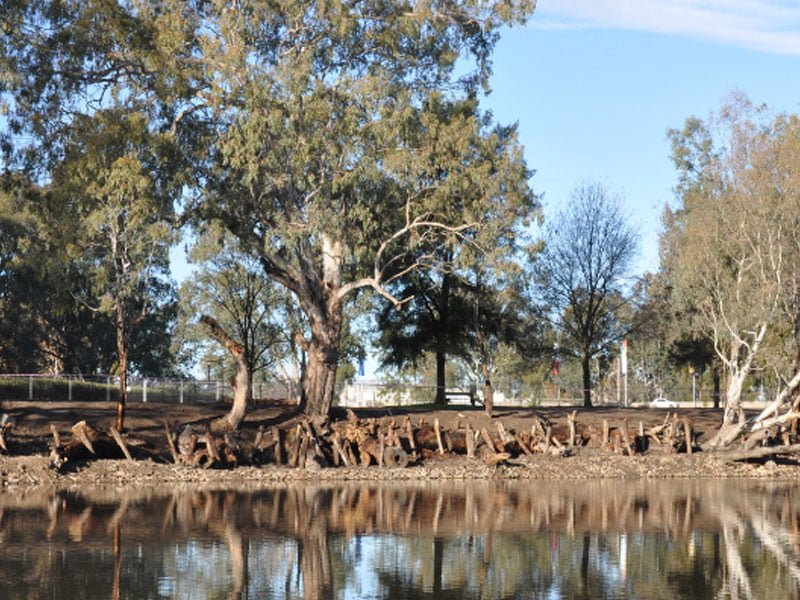

How many?
The aim should be to restore the river to its natural large woody debris load. Natural loads vary from river to river depending on the biogeographical region etc., they are best determined by direct measurements of the amount of wood present in undegraded reaches of the river, or from similar rivers nearby. Records may also be available from local river management authorities on the number of snags removed from sections of river.
More woody debris may be required in areas where the riparian zone is degraded as there is no source of re-supply. Results from some existing demonstration reaches have indicated that the more complex a snag pile is (e.g. five or six snags overlying each other) the higher number and diversity of fish the snag will accommodate (see Example 4b).
If you are interested in finding more about how ‘snags’ differ in their complexity read this article by Vic Hughes entitled ‘What snag is that?’
Type and where from?
Ideally, the woody debris used should reflect the diversity of species found naturally in the riparian zone, as the more diversity, the greater the difference in decay rates, bark, root complexity etc. Introduced species are not recommended, as they do not provide a good substrate for macro invertebrates. If possible, a range of sizes should be used. Snags should ideally have the root ball still attached and four or five large branches remaining.
It is best not to source woody debris from the riparian zone or the floodplain as the wood present is providing important terrestrial habitat. Waste from logging, or standing (green of possible) trees from clearing agricultural land, mine sites, road realignments and industrial developments may be good sources of woody debris. The closer the site is to the demonstration reach the better, as transport costs can be prohibitive.
It is recommended that the introduction of woody debris be undertaken over a number of years. If a suitable source is found it is worth stockpiling the wood if a site is available, providing protection is given to prevent termites and borers invading the tree (this happens around six months after the tree is on the ground). Snags affected by termites are lighter and harder to anchor which increases the risk of them being washed downstream during a flood (see Example 4c).
Where to place woody debris?
It is very important that local authorities are contacted and that relevant expertise is sought prior to placing woody debris. Wrongly placed woody debris could lead to increased bank erosion or endanger infrastructure (e.g. bridges) in flood conditions.
Woody debris can be placed in a variety of locations but generally they should be placed in low water velocity zones on the outside, or downstream of bends (unless they are being specifically placed for erosion control or are hard to anchor in these positions). They can be placed at different angles to the flow in order to obtain a variety of habitats. Those placed perpendicular to the flow will be most likely to create scour pools. Snags can be placed in a variety of water depths, not just in the deepest sections in order to benefit a broad range of fish species and size classes.
How to get them to the river?
Placement of woody debris in rivers requires engineering expertise and the use of heavy equipment. It should be undertaken carefully, with minimum disturbance to the riparian zone. In smaller rivers, woody debris can be placed relatively easily using excavators. In larger rivers it may be necessary to use a fixed pulley and cable system (see Nicol et al. 2004).
How to maintain stability?
In a healthy riparian zone, when large trees fall into the river, they usually remain partially anchored to the bank and relatively stable. Introduced woody debris are not likely to be as stable and may need anchoring using engineering solutions such as steel cables or by burying part of the trunk or roots (if the root ball is still intact) in the bank to mimic the natural situation (see Example 4d).
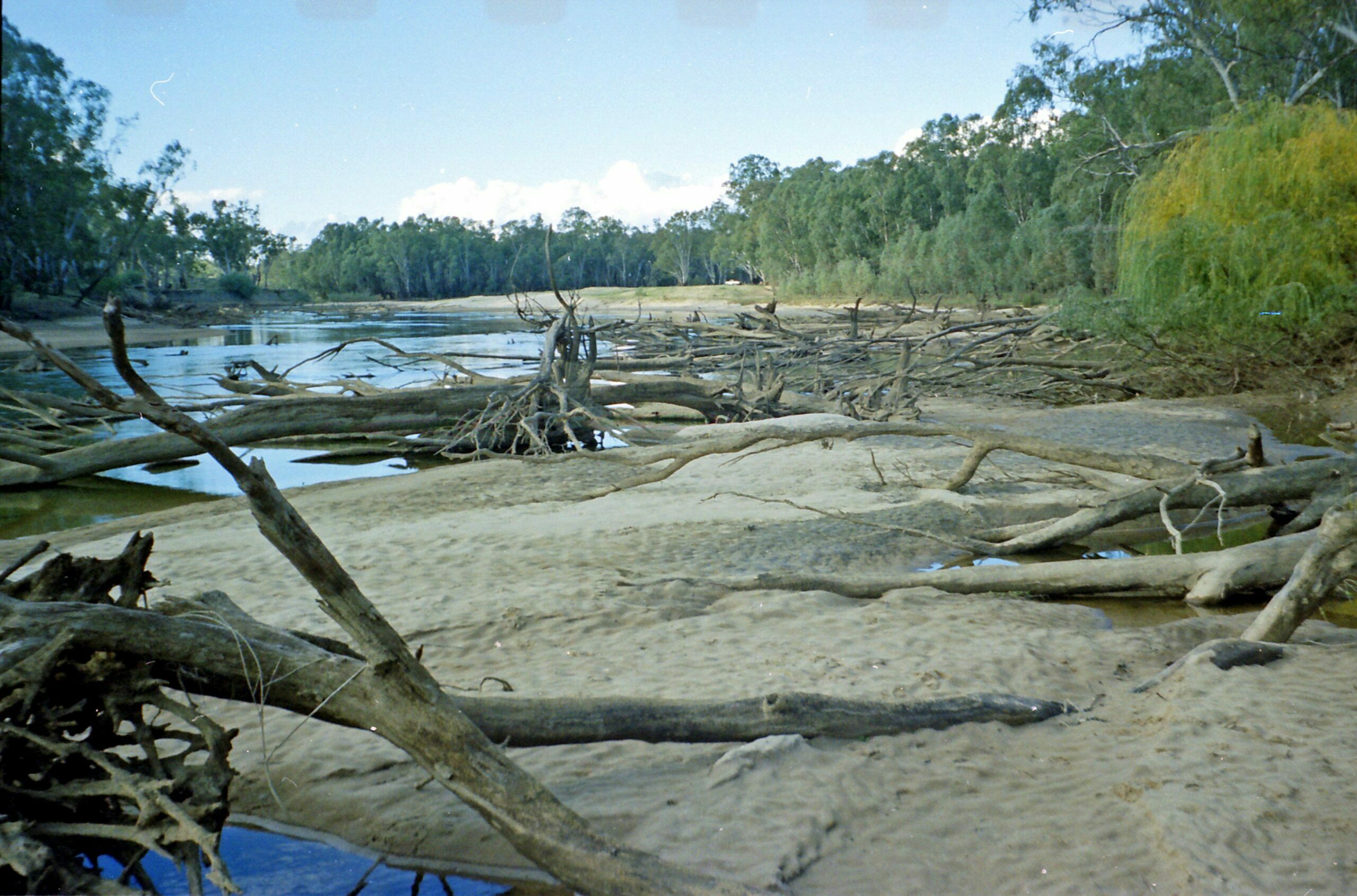
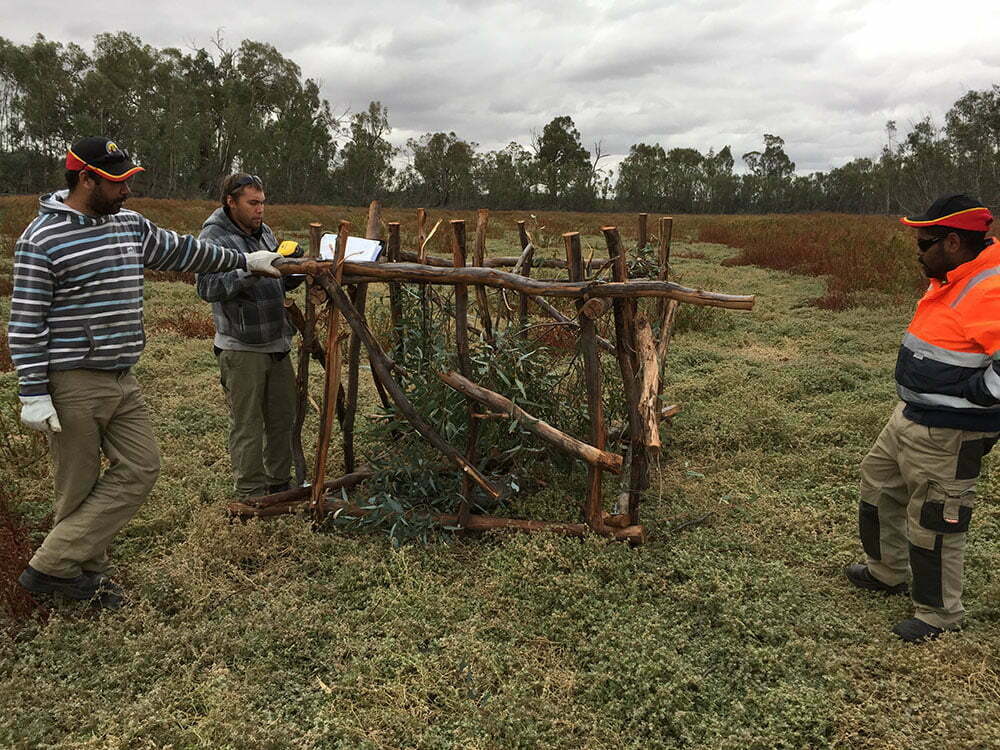
What if natural snags are unavailable?
The reintroduction of woody debris is the preferred option for rehabilitating instream habitat, but there will be instances where natural snags are not available. In these cases, natural materials such as wood or rock can be used. Some options are:
Log Piles
Sourcing a significant number of logs to pile together in one area to create diverse habitat and cover for large bodied fishes such as Murray cod and Golden perch. They need to have complexity to support native fish communities.
Fish Hotels
Wooden structures created in a variety of designs (interlinked, criss crossed, stacked) and anchored to the river bed or bank to provide habitat for fish.
LUNKERS (Little Underwater Neighbourhood Keepers Encompassing Rheotactic Salmonids)
First developed in north America they provide both bank stability and edge cover for fish. They are usually made of wood and are set into the bank. They have been successfully trialled in the Dewfish Demonstration Reach.
ELJs (Engineered Log Jams)
These are purposely engineered log groyne structures, and are used primarily as erosion control structures. They are modelled on natural log jams and, as such, are called “soft” engineering structures as they look and act more naturally in the river and also provide habitat for fish. ELJs are currently being trialled in the Upper Murrumbidgee Demonstration Reach to provide instream habitat in a stretch of river affected by a sand slug (see more details in Example 4d).
Rock Reefs
Installation of rock reefs can be used to create habitat diversity by changing water levels.
Rubble habitats
Juvenile Murray cod and Golden perch show a preference for rubble habitats (to avoid predation). These are usually located towards the head of pools in shallow water. Rubble habitats are often threatened by sedimentation and can be re-established.
Cod holes
Murray cod breed in hollows. The installation of hollow logs can increase breeding habitat. Natural logs are preferred as they provide habitat for invertebrates etc., and are more aesthetically appropriate, but old concrete pipe culverts and plastic drums have been trialled where logs are not available.
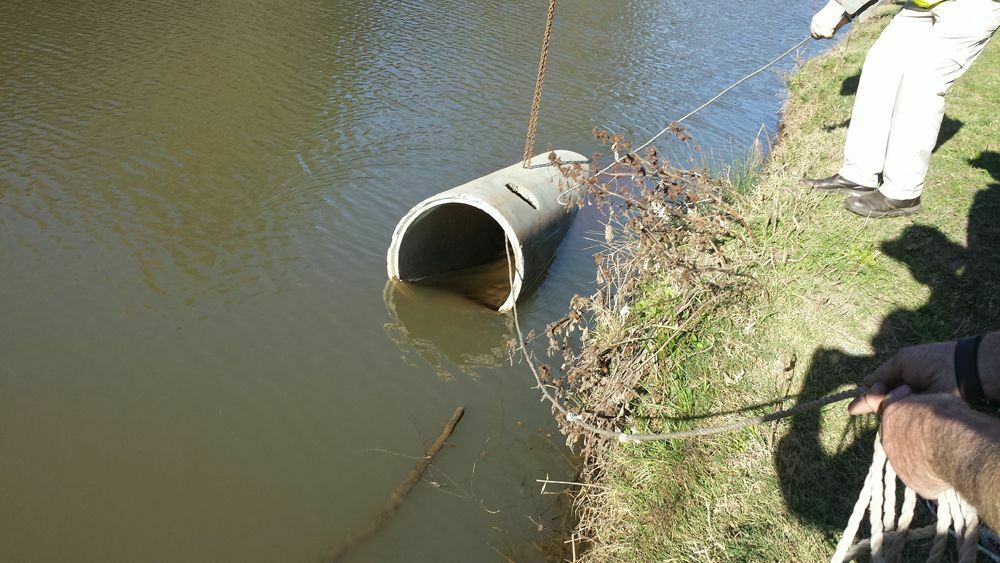
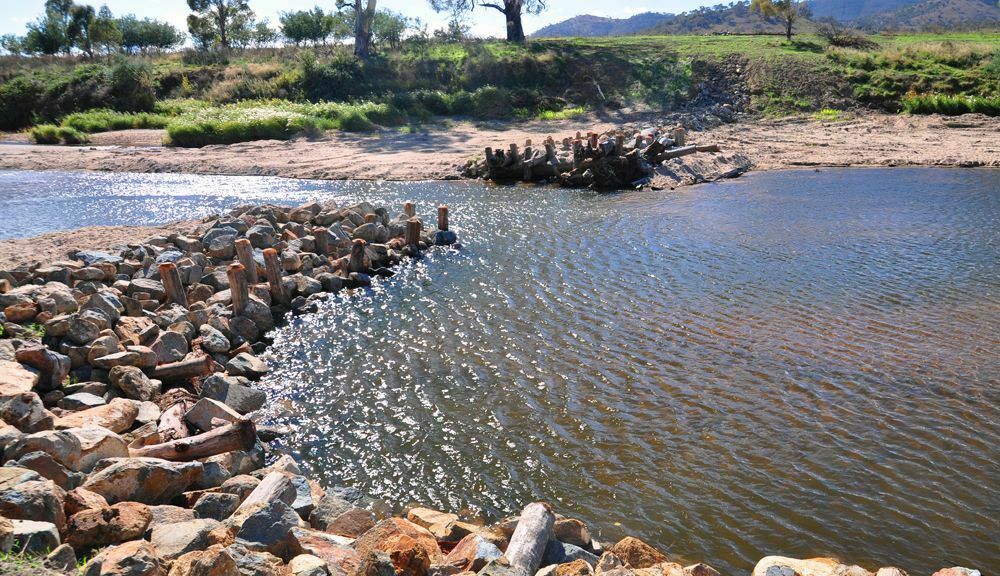
Habitat for Small Bodied Fish
Small bodied fish require different habitat to the large woody debris preferred by Murray cod and Golden perch. These fish need plenty of aquatic and emergent vegetation (partially in water), as well as rocks, rubble and smaller twigs and branches. Research conducted in the Dewfish Demonstration Reach has indicated that more focus is required on providing instream habitat for small bodied native fishes and the juveniles of large bodied native fishes, particularly when the river is recovering from recent floods.
Small bodied fish are the focus of increasing attention as many are classified as threatened. To find out more follow this link to more information about these special little fish.

Examples:
Hume Dam to Yarrawonga Resnagging Program
The program, funded under the Living Murray initiative, has resnagged 14 sites along the River Murray. A plan to identify areas for resnagging and to determine appropriate snag loads was developed in 2004. Key points were:
- A “snag assessment” collected data on existing snags including location, size, complexity, snag alignment and depths.
- Associated riparian condition and connectivity were also recorded.
- Data were also available on the number and location of snags that had been removed in the past (from “river improvement” works records).
- From this information an “instream woody habitat load” was calculated.
- Priority areas for resnagging were based on the above assessment and consideration of establishing connectivity with existing good quality instream habitat.
- Consideration was also given to practical aspects such as source of snags, transport and access to the river
Dewfish Demonstration Reach
Re-snagging of sections of this demonstration reach have been very successful with great stability achieved. The results suggest that:
- Important to select “good” snags in the first place e.g. with root ball intact and four or five good branches.
- Select sites not in full velocity flows during floods.
- Key the root ball into the bank.
- Four or five branches should dig into the bed to stop movement and prevent the snag from rolling.
- Face the trunk downstream.
- Pin the snag with at least 250mm hardwood logs.
- Logs are most likely to move within the first six months, after which they become waterlogged and hence more stable. More complex snag piles are the most stable.
Upper Murrumbidge Demonstration Reach – Tharwa Fish Habitat Project (see fact sheet)
Reintroduction of large woody debris to create habitat diversity can become problematic in waterways where there is high sediment loads. Widespread catchment erosion in the late 1800s and 1900s has caused areas of sand build up in the Murrumbidgee River (e.g. Tharwa). This has resulted in sections of the river that are very shallow with little or no instream habitat. Engineered Log Jams (ELJs) are being trialled to improve river channel deepness and fish habitat.
Key points are:
- Large Woody Debris introduced in the normal way is likely to be quickly buried under shifting sand loads.
- Well designed ELJs are a proven technique in Australia that can have positive effects on river physical and ecological functions.
- They can be expensive if a local supply of timber is not available.
- A community information session was held to inform stakeholders about the ELJs project.
- The introduction of ELJs will be accompanied by other site restoration activities including riparian plantings.
- Monitoring of the fish fauna has taken place both before and after the ELJs were constructed. So far monitoring suggests that they have improved both river channel deepness and native fish assemblages.
Brooks, P., Abbe, T., Cohen, T., Marsh, N., Mika, S., Boulton, A., Broderick, T., Borg, D. and Rutherfurd, I. 2006. Design guideline for the reintroduction of wood into Australian streams. Land and Water Australia, Canberra.
Cottingham, P., Bunn, S., Price, P. and Lovett, S. (eds) 2003. Managing Wood in streams. River and Riparian Land Management Technical Guidelines update No3, July 2003, Land and Water Australia, Canberra.
Erskine, W.D. and Webb, A.A. 2003. Desnagging to resnagging: New directions in river rehabilitation in southeastern Australia. River Research Applications, 19,233-249.
Marsh, N., Rutherfurd, I. and Jerie, K. 1999. Large woody debris in some Australian streams, natural loading, distribution and morphological effects. Second Australian Stream Management Conference, Adelaide, South Australia.
Nicol, S.J., Lieschke, J.A., Lyon, J.P. and Hughes, V. 2004. Restoring structural woody habitat in the River Murray. Native Fish Habitat rehabilitation and Management in the Murray Darling Basin, Albury Workshop, Murray-Darling Basin Commission, Canberra.
NSW Department of Primary Industries 2007. Threat abatement plan – Removal of large woody debris from NSW rivers and streams. NSW Department of Primary Industries, NSW.
Treadwell, S. 1999. Managing snags and large woody debris. In: Lovett, S. and Price, P. (eds). Riparian Land Management Technical Guidelines Volume Two: On-ground Management Tools and Techniques. Land and Water Resource Research and Development Corporation, Canberra.
Treadwell, S., Koehn, J. and Bunn, S. 1999. Large woody debris and other aquatic habitat. In: Lovett, S. and Price, P. (eds). Riparian Land Management Technical Guidelines, Volume One: Principles of Sound Management. Land and Water Resources Research and Development Corporation, Canberra.
Norris, A., Hutchison, M., Nixon, D. and Chilcott, K. 2013. Habitat preferences of small-bodied native fish. Final Report, Agri Science Queensland, Department of Agriculture Fisheries and Forestry, Brisbane.